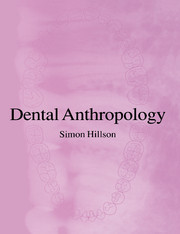Book contents
- Frontmatter
- Contents
- Acknowledgements
- Abbreviations
- 1 Introduction to dental anthropology
- 2 Dental anatomy
- 3 Variation in size and shape of teeth
- 4 Occlusion
- 5 Sequence and timing of dental growth
- 6 Dental enamel
- 7 Dentine
- 8 Dental cement
- 9 Histological methods of age determination
- 10 Biochemistry of dental tissues
- 11 Tooth wear and modification
- 12 Dental disease
- 13 Conclusion: current state, challenges and future developments in dental anthropology
- Appendix A: Field and laboratory methods
- Appendix B: Microscopy
- References
- Index
8 - Dental cement
Published online by Cambridge University Press: 05 June 2012
- Frontmatter
- Contents
- Acknowledgements
- Abbreviations
- 1 Introduction to dental anthropology
- 2 Dental anatomy
- 3 Variation in size and shape of teeth
- 4 Occlusion
- 5 Sequence and timing of dental growth
- 6 Dental enamel
- 7 Dentine
- 8 Dental cement
- 9 Histological methods of age determination
- 10 Biochemistry of dental tissues
- 11 Tooth wear and modification
- 12 Dental disease
- 13 Conclusion: current state, challenges and future developments in dental anthropology
- Appendix A: Field and laboratory methods
- Appendix B: Microscopy
- References
- Index
Summary
Introduction
A review of cement anatomy and physiology is given by Jones (1981). In primate teeth, cement coats the root surface only, mostly covering the underlying dentine, but frequently overlapping the edge of the enamel at the cervical crown margin. The thickness of the cement layer is highly variable – in an adult it may be 100–200 μm half-way up the root from the apex, and 500–600 μm at the apex itself. Thickness increases with age, and the unerupted teeth of a young individual may have a cement layer of only 10–20 μm.
The function of the cement is to attach the periodontal ligament (page 260) to the surface of the root. The ligament contains a complex of collagen fibres, embedded in the alveolar bone on one side, and embedded in the cement on the other. The cement has no blood or nervous supply of its own, but the periodontal ligament is richly supplied and the cement-forming cells (the cementoblasts) lie within it, on the cement surface. Collagen fibres in the periodontal ligament turn over rapidly, in response to dynamic changes in mechanical forces at the joint, so that the attachment of the fibres to the tooth root also changes constantly and cement is laid down throughout life to provide new attachments. The cement does not continuously turn over like this (as bone does), but it can be remodelled by the combined activities of cementdestroying cells (odontoclasts) and cementoblasts, which are able to repopulate the damaged areas (unlike odontoblasts in dentine).
- Type
- Chapter
- Information
- Dental Anthropology , pp. 198 - 206Publisher: Cambridge University PressPrint publication year: 1996



